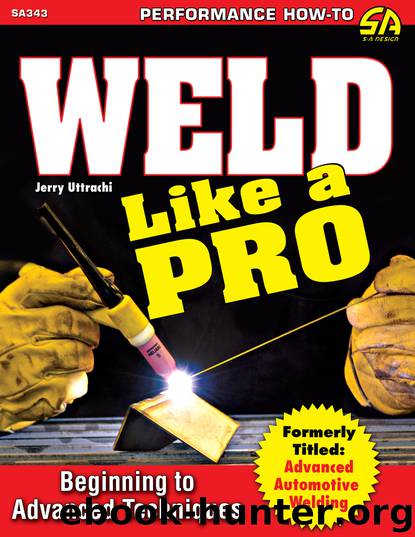Weld Like a Pro by Jerry Uttrachi

Author:Jerry Uttrachi [Uttrachi, Jerry]
Language: eng
Format: epub
ISBN: 9781613252642
Publisher: CarTech Inc.
Equipment
Conventional transformer designs are powered by 220-volt alternating-current power lines. These can provide AC or DC/AC welding power. Larger industrial stick welders are available with up to 600-amp capacity. Inerter-based designs are much lighter and can be easily moved from job to job.
Conventional Power
Stick-welding power sources can be very simple, such as the old standby seen in Figure 5.3, often referred to as the tombstone because of its shape. This particular power source can be purchased as a simple AC welder. AC welders are sometimes called buzz boxes because of the sound they make from the vibration of the current control mechanism that varies the welding current.
AC welders are also available in combination AC/DC versions. They typically weigh 150 to 175 pounds. The large internal transformer converts the 220-volt line input into welding power that may be 80 volts when not welding. And it has an output that follows a curve down to 0 volts when set at 150 amps, for example. This type of power output is called constant current because the voltage can vary as the arc length changes, but the current remains at about the preset level. Because electrode burn-off rate and weld penetration are predominately dependent on current, a weldor can produce a uniform bead.
In comparison to AC, DC power provides a more stable arc, particularly with low-current, small-diameter electrodes. DC reverse polarity, also called electrode positive, provides the best mechanical properties, specifically weld metal toughness. With reverse polarity, the arc is most stable and can be held at a short distance. A shorter arc length yields less contamination from air and produces a lower level of oxides and nitrides, which detract from toughness.
Arc Blow
This condition can occur when welding steel with DC power. During arc blow, the arc may move to one side or backward and influence weld quality and appearance. If the arc bends back, the weld is humped in the center and undercut on the edges. If it moves rapidly from side to side or randomly, it could pull air into the weld puddle and cause porosity. With DC power, the current is moving in one direction, creating a magnetic field that is circular around the electrode and arc. Any magnetic field in the base material causes the arc to move. The current flows in both directions and usually eliminates the problem of preferential magnetic fields and avoids the problems caused by arc blow.
Download
This site does not store any files on its server. We only index and link to content provided by other sites. Please contact the content providers to delete copyright contents if any and email us, we'll remove relevant links or contents immediately.
| Automotive | Engineering |
| Transportation |
Machine Learning at Scale with H2O by Gregory Keys | David Whiting(4257)
Never by Ken Follett(3875)
Urban Outlaw by Magnus Walker(3364)
OPNsense Beginner to Professional by Julio Cesar Bueno de Camargo(3261)
Sapiens and Homo Deus by Yuval Noah Harari(3027)
Will by Will Smith(2872)
A Short History of Nearly Everything by Bryson Bill(2659)
Hooked: A Dark, Contemporary Romance (Never After Series) by Emily McIntire(2527)
Rationality by Steven Pinker(2326)
Borders by unknow(2280)
The Becoming by Nora Roberts(2148)
Holy Bible (NIV) by Zondervan(2100)
HBR's 10 Must Reads 2022 by Harvard Business Review(1820)
A Short History of War by Jeremy Black(1815)
The One Percenter Encyclopedia by Bill Hayes(1810)
Freedom by Sonny Barger(1783)
Go Tell the Bees That I Am Gone by Diana Gabaldon(1729)
Five Ways to Fall by K.A. Tucker(1723)
Girls Auto Clinic Glove Box Guide by Patrice Banks(1706)
